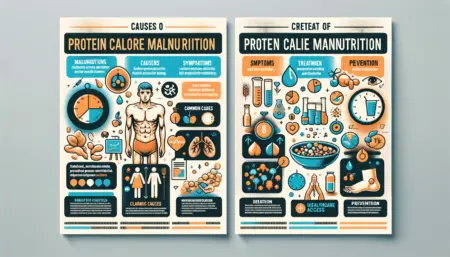Protein Calorie Malnutrition is also known as Protein–energy malnutrition.The effect of deficiency of proteins and calories on the nervous system has not yet been defined. Infants who suffer from protein-calorie deficiency are less easily conditioned, their performance on standard psychological tests is often impaired and they commonly exhibit less curiosity and exploratory behavior, being apathetic, irritable, and drowsy. Weakness, hypotonia, diminished to absent deep tendon reflexes, seizures, and coarse tremor of the extremities have been described in kwashiorkor. The electroencephalogram is said to be abnormal in 40 per cent of severely afflicted children. There have been few critical neuropathologic studies.

Experimentally induced protein calorie malnutrition in newborn pigs causes retardation of gait development. The learning ability of weanling rats fed a diet devoid of protein is markedly impaired and, in addition, spasmodic trembLing of the head and forepaws may develop. Neurologic signs are said to be striking in puppies born of malnourished bitches. Neonatal death occurs 11 in 50 per cent of the pups, and the development of the survivors is retarded. Athetoid movements of the head and neck, ataxia of gait, and seizures may develop after weaning.
Few of the large number of biochemical investigations in laboratory animals and in patients suffering from protein-calorie deficiency have dealt with the nervous system. Protein and amino acid metabolism is generally impaired; the levels of free essential amino acids are reduced in the plasma, and an adaptive reduction in enzyme activity ensues. The brains of rats fed a low- protein diet have shown a decrease in the content of gamma-aminobutyric acid, and the activity of enzymes concerned with its formation is reduced. The- levels of alanine, glutamic acid, glutamine and aspartic acid are decreased.
Severe malnutrition during fetal growth and in early infancy affects the normal structural and biochemical development of the nervous system in an irreversible manner. Intrauterine malnutrition influences the rate of cell division, resulting in decreased, brain size and cellularity. Severe malnutrition in the immediate neonatal period retards the growth of the brain as well as the metabolism of cerebral DNA, RNA, and protein, and has a marked influence on the rate of synthesis of myelin lipids.
Cerebrosides, plasmalogens, sulfatides, cholesterol, and proteolipids are significantly decreased in the white matter of malnourished infants. In the cortex the content of RNA and protein per cell is normal, yet the total number and size of cells are reduced. The younger the child, the more marked is the abnormality. Evidence gleaned from the study of laboratory animals suggests that the deficit persists despite adequate nutritional replenishment. Thus profound nutritional deprivation occurring at a particularly vulnerable period of brain development permanently and adversely affects ultimate intellectual development and behavior.
Protein-Calorie Malnutrition (PCM), also known as Protein-Energy Malnutrition (PEM), is a form of malnutrition where there is inadequate calorie or protein intake. It’s a serious health condition, particularly in children, and can lead to various health issues. Here’s a tabular guide to understand PCM better:
| Aspect | Description |
|---|---|
| Causes | – Inadequate intake of protein and calories.<br>- Prolonged fasting or starvation.<br>- Severe illnesses or infections.<br>- Diseases causing malabsorption (like cystic fibrosis, celiac disease). |
| Types | – Kwashiorkor: Protein deficiency predominant.<br>- Marasmus: Calorie deficiency predominant.<br>- Marasmic Kwashiorkor: Combination of both. |
| Symptoms | – Weight loss and muscle wasting.<br>- Stunted growth in children.<br>- Edema (in Kwashiorkor).<br>- Weakness and fatigue.<br>- Delayed wound healing.<br>- Hair and skin changes. |
| Diagnosis | – Clinical assessment (physical symptoms).<br>- Dietary history.<br>- Anthropometric measurements (like BMI).<br>- Blood tests (albumin levels, total protein). |
| Treatment | – Gradual refeeding with balanced diet.<br>- Management of hydration and electrolyte balance.<br>- Treatment of underlying infections or diseases.<br>- Nutritional supplements if necessary. |
| Prevention | – Ensuring adequate nutrition.<br>- Education about balanced diet.<br>- Early treatment of illnesses and infections.<br>- Regular health check-ups for at-risk populations. |
| Complications | – Immune system impairment.<br>- Increased susceptibility to infections.<br>- Organ dysfunction.<br>- Developmental delays in children.<br>- In severe cases, death. |
Remember, PCM is a preventable and treatable condition. Adequate nutritional intake and timely medical intervention are key to managing this condition effectively.
Conclusion
Protein Calorie Malnutrition continues to be a pressing global issue, affecting vulnerable populations across the world. Understanding its causes, recognizing the symptoms, and implementing effective interventions are crucial steps towards combating PCM and improving overall health and well-being. By addressing the silent epidemic of PCM, we can work towards a future where no individual suffers from the detrimental effects of inadequate protein and calorie intake.
